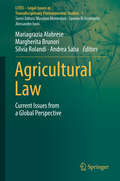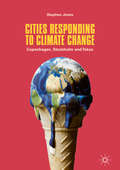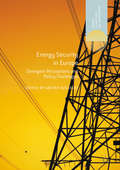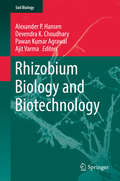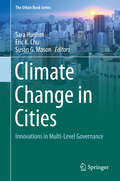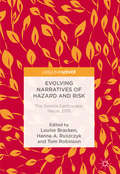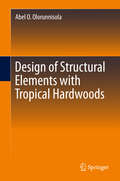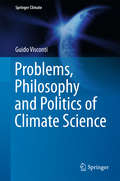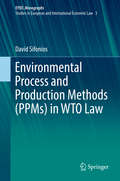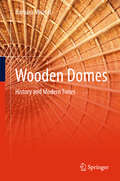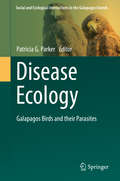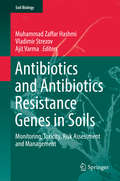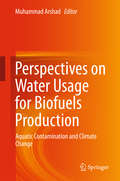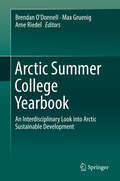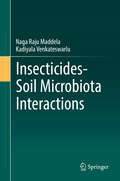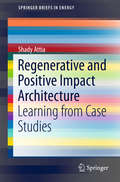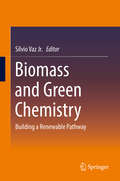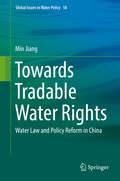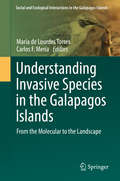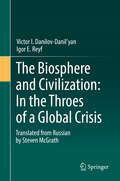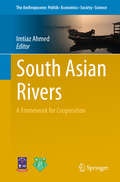- Table View
- List View
Agricultural Law: Current Issues from a Global Perspective (LITES - Legal Issues in Transdisciplinary Environmental Studies #1)
by Mariagrazia Alabrese Margherita Brunori Silvia Rolandi Andrea SabaThis book focuses on the social and environmental issues being addressed by agricultural law within the current globalised system.What is agricultural law? Agricultural regulations concern and affect essential human needs and values that must be dealt with by pursuing a comprehensive and coordinated global approach. By tracking the developments in this context, this book explores the new challenges that agricultural law needs to address in order to frame emerging dilemmas.International governance of natural resources and their role in addressing food insecurity is the object of the first Part of the volume, which deals with sustainable agriculture and agro-ecosystem services in connection with the food security issue.The second Part focuses on the regulation of food as the main product of agricultural activity, and explores the answers that the law can provide in order to accommodate consumers’ interests and concerns (inter alia, novel foods, animal welfare, direct sales and e-commerce). The third Part examines the social, environmental and legal consequences of a renewed interest in agricultural investments. Further, it analyses the evolution and the interplay between different legal systems with regard to land tenure, environmental concerns and investments in agriculture.
Cities Responding to Climate Change: Copenhagen, Stockholm and Tokyo
by Stephen JonesThis book explores the climate policy approaches established by various city governments. It details the strategies, plans and initiatives that have so far been designed to both mitigate and adapt to the impacts of global warming. In doing so, it considers the implications of the actions taken by leading cities and its effects on underlying theoretical assumptions relating to policy development and management processes in achieving climate policy outcomes. Cities Responding to Climate Change establishes an analytical framework that critically examines the application of performance management by city governments in their policy responses to climate change. It draws its focus on the city governments of Copenhagen, Stockholm and Tokyo to bring together and discuss the concepts, strategies and practices that have since been introduced to respond to the climate challenges faced. This book highlights the lessons to be learned by other city governments around the world contemplating serious action with climate policies to lessen the impacts of global warming. It will be of particular interest to practitioners and researchers seeking evidence of how governments deliver on their commitments and improve their effectiveness in implementing climate polices.
Cities Responding to Climate Change: Copenhagen, Stockholm and Tokyo
by Stephen JonesThis book explores the climate policy approaches established by various city governments. It details the strategies, plans and initiatives that have so far been designed to both mitigate and adapt to the impacts of global warming. In doing so, it considers the implications of the actions taken by leading cities and its effects on underlying theoretical assumptions relating to policy development and management processes in achieving climate policy outcomes. Cities Responding to Climate Change establishes an analytical framework that critically examines the application of performance management by city governments in their policy responses to climate change. It draws its focus on the city governments of Copenhagen, Stockholm and Tokyo to bring together and discuss the concepts, strategies and practices that have since been introduced to respond to the climate challenges faced. This book highlights the lessons to be learned by other city governments around the world contemplating serious action with climate policies to lessen the impacts of global warming. It will be of particular interest to practitioners and researchers seeking evidence of how governments deliver on their commitments and improve their effectiveness in implementing climate polices.
Energy Security in Europe: Divergent Perceptions and Policy Challenges
by Kacper SzuleckiThis edited collection highlights the different meanings that have been attached to the notion of energy security and how it is taken to refer to different objects. Official policy definitions of energy security are broadly similar across countries and emphasize the reliability and affordability of access to sufficient energy resources for a community to uphold its normal economic and social functions. However, perceptions of energy security vary between states causing different actions to be taken, both in international relations and in domestic politics. Energy Security in Europe moves the policy debates on energy security beyond a consideration of its seemingly objective nature. It also provides a series of contributions that shed light on the conditions under which similar material factors are met with very different energy security policies and divergent discourses across Europe. Furthermore, it problematizes established notions prevalent in energy security studies, such as whether energy security is ‘geopolitical’, and an element of high politics, or purely ‘economic’, and should be left for the markets to regulate. This book will be of particular relevance to students and academics in the fields of energy studies and political science seeking to understand the divergence in perspectives and understandings of energy security challenges between EU member states and in multilateral relationships between the EU as a whole.
Energy Security in Europe: Divergent Perceptions and Policy Challenges
by Kacper SzuleckiThis edited collection highlights the different meanings that have been attached to the notion of energy security and how it is taken to refer to different objects. Official policy definitions of energy security are broadly similar across countries and emphasize the reliability and affordability of access to sufficient energy resources for a community to uphold its normal economic and social functions. However, perceptions of energy security vary between states causing different actions to be taken, both in international relations and in domestic politics. Energy Security in Europe moves the policy debates on energy security beyond a consideration of its seemingly objective nature. It also provides a series of contributions that shed light on the conditions under which similar material factors are met with very different energy security policies and divergent discourses across Europe. Furthermore, it problematizes established notions prevalent in energy security studies, such as whether energy security is ‘geopolitical’, and an element of high politics, or purely ‘economic’, and should be left for the markets to regulate. This book will be of particular relevance to students and academics in the fields of energy studies and political science seeking to understand the divergence in perspectives and understandings of energy security challenges between EU member states and in multilateral relationships between the EU as a whole.
Rhizobium Biology and Biotechnology (Soil Biology #50)
by Alexander P. Hansen Devendra K. Choudhary Pawan Kumar Agrawal Ajit VarmaThis book provides in-depth reviews of the role of Rhizobium in agriculture and its biotechnological applications. Individual chapters explore topics such as: the occurrence and distribution of Rhizobium; phenotypic and molecular characteristics of Rhizobium; impact of Rhizobium on other microbial communities in the rhizosphere; N2-fixation ability of Rhizobium; Rhizobium and biotic stress; Rhizobium-mediated restoration of an ecosystem; in silico analysis of the rhizobia pool; further biotechnological perspectives of Rhizobium.
Climate Change in Cities: Innovations in Multi-Level Governance (The Urban Book Series)
by Sara Hughes Eric K. Chu Susan G. MasonThis book presents pioneering work on a range of innovative practices, experiments, and ideas that are becoming an integral part of urban climate change governance in the 21st century. Theoretically, the book builds on nearly two decades of scholarships identifying the emergence of new urban actors, spaces and political dynamics in response to climate change priorities. However, it further articulates and applies the concepts associated with urban climate change governance by bridging formerly disparate disciplines and approaches. Empirically, the chapters investigate new multi-level urban governance arrangements from around the world, and leverage the insights they provide for both theory and practice. Cities - both as political and material entities - are increasingly playing a critical role in shaping the trajectory and impacts of climate change action. However, their policy, planning, and governance responses to climate change are fraught with tension and contradictions. While on one hand local actors play a central role in designing institutions, infrastructures, and behaviors that drive decarbonization and adaptation to changing climatic conditions, their options and incentives are inextricably enmeshed within broader political and economic processes. Resolving these tensions and contradictions is likely to require innovative and multi-level approaches to governing climate change in the city: new interactions, new political actors, new ways of coordinating and mobilizing resources, and new frameworks and technical capacities for decision making. We focus explicitly on those innovations that produce new relationships between levels of government, between government and citizens, and among governments, the private sector, and transnational and civil society actors. A more comprehensive understanding is needed of the innovative approaches being used to navigate the complex networks and relationships that constitute contemporary multi-level urban climate change governance. Debra Roberts, Co-Chair, Working Group II, IPCC 6th Assessment Report (AR6) and Acting Head, Sustainable and Resilient City Initiatives, Durban, South Africa “Climate Change in Cities offers a refreshingly frank view of how complex cities and city processes really are.”Christopher Gore, Associate Professor and Chair, Department of Politics and Public Administration, Ryerson University, Canada“This book is a rare and welcome contribution engaging critically with questions about cities as central actors in multilevel climate governance but it does so recognizing that there are lessons from cities in both the Global North and South.”Harriet Bulkeley, Professor of Geography, Durham University, United Kingdom“This timely collection provides new insights into how cities can put their rhetoric into action on the ground and explores just how this promise can be realised in cities across the world - from California to Canada, India to Indonesia.”
Evolving Narratives of Hazard and Risk: The Gorkha Earthquake, Nepal, 2015
by Louise Bracken Hanna A. Ruszczyk Tom RobinsonThis book presents a range of academic research and personal reflections on the Gorkha earthquake that struck Nepal in 2015. For the first time, perspectives from geography, disaster risk reduction, cultural heritage protection, archaeology, anthropology, social work, health and emergency response are discussed in a single volume. Contributions are included from practitioners and researchers from Nepal and Durham University in the UK, many of whom were in Nepal at the time of the earthquake.Evolving Narratives of Hazard and Risk explores the event of the earthquake, its consequences and its impacts, to provide a holistic and multi-perspective understanding of this special hazard and its significant ramifications for social, political, economic and cultural aspects of life in Nepal. The book highlights how these multiple perspectives are needed to inform each other in order to develop and shape new ways of thinking and interacting with environmental hazards. This collection of works will be of interest to students and academics of Environment Studies, Human Geography and Environmental Policy, and will be of particular relevance to those involved in risk research and managing risk and hazard events.
Evolving Narratives of Hazard and Risk: The Gorkha Earthquake, Nepal, 2015
by Louise Bracken Hanna A. Ruszczyk Tom RobinsonThis book presents a range of academic research and personal reflections on the Gorkha earthquake that struck Nepal in 2015. For the first time, perspectives from geography, disaster risk reduction, cultural heritage protection, archaeology, anthropology, social work, health and emergency response are discussed in a single volume. Contributions are included from practitioners and researchers from Nepal and Durham University in the UK, many of whom were in Nepal at the time of the earthquake.Evolving Narratives of Hazard and Risk explores the event of the earthquake, its consequences and its impacts, to provide a holistic and multi-perspective understanding of this special hazard and its significant ramifications for social, political, economic and cultural aspects of life in Nepal. The book highlights how these multiple perspectives are needed to inform each other in order to develop and shape new ways of thinking and interacting with environmental hazards. This collection of works will be of interest to students and academics of Environment Studies, Human Geography and Environmental Policy, and will be of particular relevance to those involved in risk research and managing risk and hazard events.
Design of Structural Elements with Tropical Hardwoods
by Abel O. OlorunnisolaThis book provides basic information on the design of structures with tropical woods. It is intended primarily for teaching university- and college-level courses in structural design. It is also suitable as a reference material for practitioners. Although parts of the background material relate specifically to West and East Africa, the design principles apply to the whole of tropical Africa, Latin America and South Asia. The book is laced with ample illustrations including photographs of real life wood structures and structural elements across Africa that make for interesting reading. It has numerous manual and Excel spread sheet worked examples and review questions that can properly guide a first-time designer of wooden structural elements. A number of design problems are also solved using the FORTRAN programming language. Topics covered in the thirteen chapters of the book include a brief introduction to the book, the anatomy and physical properties of tropical woods; a brief review of the mechanical properties of wood, timber seasoning and preservation, uses of wood and wood products in construction; basic theory of structures, and structural load computations; design of wooden beams, solid and built-up wooden columns, wood connections and wooden trusses; as well as a brief introduction to the design of wooden bridges.
Problems, Philosophy and Politics of Climate Science (Springer Climate)
by Guido ViscontiThis book is a critical appraisal of the status of the so-called Climate Sciences (CS). These are contributed by many other basic sciences like physics, geology, chemistry and as such employ theoretical and experimental methods. In the last few decades most of the CS have been identified with the global warming problem and numerical models have been used as the main tool for their investigations. The produced predictions can only be partially tested against experimental data and may represent one of the reasons CS are drifting away from the route of the scientific method. On the other hand the study of climate faces many other interesting and mostly unsolved problems (think about ice ages) whose solution could clarify how the climatic system works. As for the global warming, while its existence is largely proved, scientifically it can be solved only with a large experimental effort carried out for a few decades. Problems can arise when not proved hypotheses are adopted as the basis for public policy without the recognition that they may be on shaky ground. The strong interactions of the Global Warming (GW) with the society create another huge problem of political nature for the CS. The book argues that the knowledge gained so far on the specific GW problem is enough for the relevant political decisions to be taken and that Climate Science should resume the study of the climate system with appropriate means and methods. The book introduces the most relevant concepts needed for the discussion in the text or in appropriate appendices and it is directed to the general public with upper undergraduate background. Each chapter closes with a debate between a climate scientist and a humanist to reflect the discussions between climate science and philosophy or climate scientists and society.
Environmental Process and Production Methods (European Yearbook of International Economic Law #3)
by David SifoniosThis book examines the conditions under which PPM measures may be adopted under WTO law de lege lata and de lege ferenda. It analyses in detail the complex case law in this field and its evolution in the last 25 years, as well as the many doctrinal debates around PPM measures and their relevance in the light of the evolution of case law, both under the GATT and the TBT Agreement. Further, it also suggests an original approach to the interpretation of the relevant provisions of the GATT and the TBT Agreement in the context of PPM measures. The PPM issue has been one of the most debated topics in the trade and environment debate. Even though the US–Shrimp case showed that PPM measures are not prohibited per se under the GATT, many questions remain unanswered when it comes to the precise conditions under which environmental PPM measures are justifiable under WTO law, for example in the field of trade measures relating to climate change mitigation efforts, natural resources management policies and biodiversity conservation measures.
Wood Polymer Nanocomposites: Chemical Modifications, Properties and Sustainable Applications (Engineering Materials)
by Md Rezaur RahmanThis book shows how chemical modifications influence some properties of wood nanocomposites. It describes suitable and effective chemical modifications that strengthen the physico-mechanical, thermal and morphological properties of wood. The authors provide intuitive explanation of the various types of chemical modifications applied to polymer cell walls in wood. They emphasize the reaction changes in wood cell walls due to the chemical modifications. Increased mechanical strength, improved thermal stability as well as the efficient retardancy against fungi attack are described. This book concludes summarizing the potential applications of wood-based nanocomposites taking into account sustainability and economic aspects.
Wooden Domes: History and Modern Times
by Barbara MisztalThis monograph presents a state-of-the-art analysis of eco-friendly and aesthetic structures in wooden dome construction. The author demonstrates that the further development of wooden structures depends on both supplementing the testing of wood as a heterogeneous material, as well as on further improvement of fibrous structures with visco-elastic properties. The target audience primarily comprises research experts and practitioners in the field of building materials who are interested in innovative architecture.
Disease Ecology: Galapagos Birds and their Parasites (Social and Ecological Interactions in the Galapagos Islands)
by Patricia G. ParkerThis book provides the first collection of chapters written by scientists who have contributed to the understanding of disease ecology in the Galapagos Islands, an iconic and historic natural site. The Galapagos Archipelago straddles the equator in the eastern Pacific Ocean, almost 1000 km off the coast of Ecuador, and includes 13 major islands, numerous smaller satellite islands, and many more even smaller islets. The wildlife on the Galapagos Islands today represents one of the best-preserved wild communities of plants and animals in the world, owing to the location of the islands at the intersection of major ocean currents, the commitment by Ecuador for the vast majority of the area to be left undeveloped, and the protection provided by the Galapagos National Park. Most of the animal species in Galapagos are endemic, occurring nowhere else. But they are descendants of ancestors that colonized earlier, and then, isolated from their mainland origins, evolved into forms that are recognized as distinct today. Since 2001, many of the authors of this book have been part of a four-institution partnership investigating the threats posed by pathogens to Galapagos avifauna. They approach the topic of disease ecology in a novel manner, starting with the history of arrival of both the birds themselves and the pathogens. This synthetic approach requires the integration of themes from veterinary medicine, epidemiology, population genetics, and phylogenetics.
Antibiotics and Antibiotics Resistance Genes in Soils: Monitoring, Toxicity, Risk Assessment and Management (Soil Biology #51)
by Muhammad Zaffar Hashmi Vladimir Strezov Ajit VarmaThis book summarizes the current state of knowledge regarding antibiotics and antibiotics resistance genes (ARGs) in the soil environment. It covers a wide range of topics to help readers understand antibiotics and ARGs in soils, the risks they pose for the environment, and options for effective control. In addition, it presents a range of essential tools and methodologies that can be used to address antibiotics and ARGs in a consistent, efficient, and cost-effective manner.Gathering contributions by international experts, the book addresses both theoretical aspects and practical applications.The topics discussed include antibiotics-producing microorganisms; the routes of entry and fate of antibiotics and resistance genes; biomonitoring approaches; dissemination of ARGs in soils; risk assessment; the impact of antibiotics and ARGs on the soil microbial community and other biota; bioremediation and biodegradation approaches; and soil management strategies for antibiotics and ARG-contaminated soils.As such, the book will be of interest to students, researchers and scholars in environmental science and engineering, toxicology, the medical and pharmaceutical sciences, environmental biotechnology, soil sciences, microbial ecology and plant biotechnology.Readers and Journals:1. This new volume on antibiotics and antibiotics resistance genes (ARGs) in the soil environment will be of interest to students, researchers and scholars in environmental science and engineering, toxicology, the medical and pharmaceutical sciences, environmental biotechnology, soil sciences,microbial ecology and plant biotechnology.2. The book will provide government authorities all over the world with effective strategies for the management of antibiotics and antibiotics resistance genes (ARG)- contaminated soil. 3. Gathering contributions by international experts,the book addresses both theoretical aspects and practical applications.
Perspectives on Water Usage for Biofuels Production: Aquatic Contamination and Climate Change
by Muhammad ArshadThe book integrates the fundamental factors that determine current and future impacts of biofuels production on water supply and demand in the context of climatic changes. The effects of biofuels production on ground water quality with increasing water scarcity are examined, and the utilization of water sources in the commercial scale production of biofuels are sketched, covering the complete route from growing of crops to biorefinery. Biofuel's chemical composition, characteristics and uses as fuel in terms of water consumption are also investigated. Overall, the diversity of biomass, various technological approaches and microbial contribution are reviewed.Learning objectives on this topic are presented by means of a series of tables and figures in order to guide both professionals and students. The present manuscript deals with biofuel and bioenergy courses and is therefore invaluable to students. The book provides thorough coverage of all industrial aspects of biofuels production, including impacts of climate change and water availability. It will play vital role for industry employees involved in product development, production management, quality management and helpful source to those studying for professional qualification. Academics involved in teaching elements of the subject and persons involved in an environment regulatory capacity would be able to take advantage from this book.
Arctic Summer College Yearbook: An Interdisciplinary Look into Arctic Sustainable Development
by Brendan O'Donnell Max Gruenig Arne RiedelThis book highlights both the diversity of perspectives and approaches to Arctic research and the inherent interdisciplinary nature of studying and understanding this incomparable region. The chapters are divided into four liberally-defined sections to provide space for dynamic interpretation and dialogue in search of sustainable solutions to the issues facing the Arctic. From governance to technology, scientific research to social systems, human health to economic development, the authors discuss fundamental questions while looking toward the Arctic’s future. Whether the reader is well-versed in the history and complexity of Arctic policy or looking for an insightful introduction to the vast world of Arctic research, everyone will find answers that lead to new questions and even more discoveries in these pages, laying the foundation for tomorrow’s discussion on the future of the Arctic. The Arctic’s unique geographic and political characteristics pose questions for the international community, indigenous peoples, and economic interests not easily answered through traditional concepts. To that end, the Arctic Summer College has been engaging leading professionals, students, scholars, and policy makers from across the globe to exchange ideas and support further investigation into the Arctic. A joint venture between Ecologic Institute US and Ecologic Institute Berlin (Germany), the College participates at the annual Arctic Circle Assembly in Reykjavik, Iceland, and continues to be at the forefront of international collaboration in this critical area of economic, political, environmental, and humanitarian development.
Insecticides−Soil Microbiota Interactions
by Naga Raju Maddela Kadiyala VenkateswarluThis book provides information about the nontarget nature of selected soil enzymes which are implicated in soil fertility and health and the methods for their assay. It also shows how these soil enzymes are affected by two different pesticides, buprofezin and acephate, used both extensively and intensively in modern agriculture.
Regenerative and Positive Impact Architecture: Learning from Case Studies (SpringerBriefs in Energy)
by Shady AttiaThis book is a guide to energy efficiency and environmental impact assessment in high-performance buildings projects. It compares four state-of-the-art buildings to examine the steps needed for a transition from negative impact reduction architecture to positive impact regenerative architecture, utilizing life cycle analysis. The book provides a solid grounding in the areas of energy-efficient building and building materials life-cycle assessment, discussing carbon efficiency within a wider context that includes its technical, socio-cultural and environmental dimensions and covers the key areas for green buildings performance (operational and embodied energy). The analysis and comparison of four case studies of state-of-art modern building projects in Europe and North America serve as inspiring examples for architects and building professionals in the fields of high performance buildings, ecological materials and carbon efficiency.
Biomass and Green Chemistry: Building a Renewable Pathway
by Sílvio Vaz Jr.This book investigates the main vegetable biomass types, their chemical characteristics and their potential to replace oil as raw material for the chemical industry, according to the principles of green chemistry. Authors from different scientific and technical backgrounds, from industry and academia, give an overview of the state of the art and ongoing developments. Aspects including bioeconomy, biorefineries, renewable chemistry and sustainability are also considered, given their relevance in this context. Furthermore, the book reviews green chemistry principles and their relation to biomass, while also exploring the main processes for converting biomass into bioproducts. The need to develop renewable feedstock for the chemical industry to replace oil has been identified as a major strategic challenge for the 21st century. In this context, the use of different types of vegetable biomass – starch, lignocellulosic, oleaginous, saccharide and algae – can be seen as a viable alternative to the use of non-renewable, more expensive raw materials. Furthermore, it offers a model for adding economic value to the agro industrial chains such as soybean, sugarcane, corn and forests, among others. This will in turn contribute to the sustainability of a wide range of chemicals, mainly organics and their transformation processes, which are widely used by modern society.
Towards Tradable Water Rights: Water Law and Policy Reform in China (Global Issues in Water Policy #18)
by Min JiangThis book provides a first comprehensive legal examination of water rights arrangements and water rights trading in China. Although recent water reform in China has made substantial progress in policy development and practice, how its legal and institutional framework facilitates or hinders the application of tradable water rights remains less addressed in the existing scholarship. Against the backdrop of China’s water reform and the wider international debate in water governance, this book aims to provide an innovative approach to the complex issue of water governance by critically analysing the recent legal and policy developments in China towards tradable water rights. It examines the deficiencies of the current systems for water rights arrangements and trading, explores how China may learn from and build on the international trends in water rights trading practice (mainly Australia and the US), and proposes legal and policy frameworks for defining and administering tradable water rights in China that underpin sustainable water use in the face of exacerbated water scarcity, variability, and uncertainty. All in all, the book proposes pragmatic strategies for China’s water law and policy reform to move towards tradable water rights, which encompasses a comprehensive prescription from initialising and defining tradable water rights to administering water rights and trading. By reflecting on the deepening water reforms in both China and other jurisdictions, the book aims to contribute to the international water governance debate by exploring from a legal and policy perspective, how China, comparative to other cases around the world, can find a balanced combination of water allocation mechanisms to address its water challenges. It is hoped that the observations and proposed implications for China’s water reform will contribute to developing a better understanding of the way in which experiences in water markets can be shared from jurisdiction to jurisdiction.
Understanding Invasive Species in the Galapagos Islands: From the Molecular to the Landscape (Social and Ecological Interactions in the Galapagos Islands)
by María De Torres Carlos F. MenaThis book investigates the introduction of invasive species and their behavior in oceanic islands. How can we define invasive species? What is their history? How did they come to dominate and transform ecosystems? These are relevant questions when trying to understand the behavior of invasive species—primarily in fragile ecosystems such as islands—and to understand the biological, ecological, social and economic impacts of invasions.We chose the Galapagos Islands, a place well-known to be unique in the study of evolution, as a laboratory to analyze the interactions between invasive and endemic species, to understand the makeup of the ecosystems emerging after invasions have occurred, to describe the relationships of invasives with the people that live in these islands, and to try to develop comprehensive analyses on this topic from multi-scalar and multi-disciplinary points of view. For a long time, the discussion has been about how proper management of the species could achieve two main goals: the eradication of the species to recover affected ecosystems and the conservation of endemic species. The discussion has taken on other nuances, including the suggestion that an invasive species, when it is already adapted to an ecosystem, forms an integral part of it, and thus eradication would in itself go against conservation. On the other hand, some invasive species are not only part of the biological compound of the island ecosystems, but they also form part of the social and cultural history of the inhabited islands. Some of these identified by the local inhabitants are species of real or potential economic value.
The Biosphere and Civilization: In the Throes of a Global Crisis
by Victor I. Danilov-Danil'yan Igor E. ReyfThis monograph explores the dire ecological, social, and economic situations facing mankind through comprehensive analyses of global ecological issues, poverty, environmental stability and regulation, and sustainable development. Drs. Victor Danilov-Danil’yan and Igor Reyf discuss the development of ecology as a science, the increasing concern among scientists and public servants for the unsustainability of current economic and demographic trends, and the dire consequences our planet and civilization are already suffering as a result of the ongoing environmental and social crisis. They also address the philosophical implications of the crisis, and suggest possible solutions. The book conveys complex objects of study, namely the biosphere and the harmful anthropogenic processes it has been experiencing for decades, so that the work is accessible without omitting key components of the subject matter. Readers will learn about the social and economic contributors to a threatened biosphere, the mechanisms that maintain the stability of the global environment, and the scales at which sustainable development and preservation can be applied to initiate environmental regulation. Though intended to appeal to the general public and non-specialists, environmental researchers, organizations involved in sustainable development and conservation, and students engaged in ecology, environment, and sustainability studies will also find this book of interest.
South Asian Rivers: A Framework for Cooperation (The Anthropocene: Politik—Economics—Society—Science #21)
by Imtiaz AhmedThis volume identifies existing statist approaches and political economies of river management in South Asia. These rivers are heavily suffering from millions of people who in contrast consider them as holy and worship them. Edited by Professor Imtiaz Ahmed, the contributors of this book from India, Nepal and Pakistan are leading readers on a journey through the transboundary rivers of South Asia where rivers are vital for the life and living. The book explains why the region needs a framework for cooperation on the wellbeing of these rivers. River management is the key to sustaining healthy river systems. The authors stress that right of the rivers must be codified and guaranteed by the state and the people in South Asia. However, the statist approach to the transboundary rivers in South Asia actually conceives them as national rivers. This volume contributes to the current campaign of overcoming the water dystopias in South Asia.
